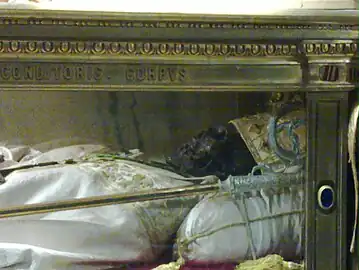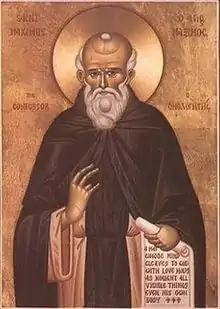January 1 - Eastern Orthodox liturgical calendar - January 3
All fixed commemorations below are observed on January 15 by Eastern Orthodox Churches on the Old Calendar.[note 1]
For January 2nd, Orthodox Churches on the Old Calendar commemorate the saints listed on December 20.
Feasts
- Forefeast of the Theophany of Our Lord and Savior Jesus Christ.[1][note 2]
Saints
- Saint Theodota, mother of the holy Unmercenaries Saints Cosmas and Damian (3rd century)[1][3]
- Martyr Sergius, by the sword, at Caesarea in Cappadocia (301)[1][4]
- Martyr Theopistus (Theopistos), by stoning.[5]
- Hieromartyr Theogenes, Bishop of Parium on the Hellespont (c. 320)[1][6][7]
- Saint Sylvester, Pope of Rome (335)[1][8][9] (see also December 31 - Latin Calendar)
- Martyr Basil of Ancyra, under Julian the Apostate (362)[10] (see also January 1 - Slavonic)
- Hieromartyr Isidore, Bishop of Syrian Antioch, by the Arians (4th century)[11][12]
- Saint Theopemtus, Monk.[13]
- Saint Mark the deaf-mute.[14]
- Saint Amun of Tabennisi, monk (4th century)[1][15] (see also October 4 - Greek)
Pre-Schism Western saints
- Martyrs Artaxus, Acutus, Eugenda, Maximianus, Timothy, Tobias and Vitus, in Syrmium in Pannonia (3rd–4th century)[16]
- Martyrs of Rome, many martyrs who suffered in Rome under Diocletian for refusing to give up the Holy Scriptures (c. 303)[16][note 3]
- Thousand Martyrs of Lichfield ('field of bodies') in England:
- Saint Martinianus of Milan (Maternian), Bishop of Milan in Italy, took part in the Third Oecumenical Council at Ephesus and wrote against Nestorianism (c. 435)[12][16]
- Saint Aspasius of Auch, Bishop of Auch in France, took part in the Second, Fourth, and Fifth Councils of Orleans in 533, 541 and 549, besides holding a council in Auch in 551 (c. 560)[16]
- Saint Schottin (Schotin, Scarthin), hermit of Kilkenny, Ireland (6th century)[1][note 6] (see also January 6)
- Saint Seiriol the Righteous, Abbott of Penmon Priory, brother of King Cynlas of Rhos and King Einion of Llŷn (6th century)[19] (see also February 1 - Latin Calendar)
- Saint Munchin the Wise (Mainchín of Limerick), probably the first Bishop of Limerick and also its patron-saint (late 6th century)[16]
- Saint Blidulf (Bladulf), a monk at Bobbio Abbey in Italy who bravely denounced the heresy of the Lombard King Ariovald, an Arian (c. 630)[16]
- Saint Vincentian (Viance, Viants), a disciple of St Menelaus, he became a hermit near Tulle in Auvergne in France (c. 730)[16]
- Saint Adalard of Corbie (827)[16][note 7]
Post-Schism Orthodox saints
- Saint Cosmas I of Constantinople the Wonderworker, Patriarch of Constantinople (1081)[1][15][20]
- Saint Sylvester of the Kiev Caves (12th century)[1][15][21][note 8]
- Righteous Juliana of Lazarevo (1604)[1][15][23][24]
- New Martyr George (Zorzes, Zorsisus) the Georgian, at Mytilene (1770)[1][15][25][26]
- Repose (1833) and Second Finding (1991) of the Relics of St. Seraphim of Sarov, Wonderworker of Sarov[1][15][27][28][note 9]
New martyrs and confessors
Other commemorations
Icon gallery



 Relics of Saint Martinianus of Milan, in the Cathedral of Milan.
Relics of Saint Martinianus of Milan, in the Cathedral of Milan. Mosaic of Saint Seiriol the Righteous, Abbott of Penmon Priory.
Mosaic of Saint Seiriol the Righteous, Abbott of Penmon Priory. Righteous Juliana of Lazarevo.
Righteous Juliana of Lazarevo. Saint Seraphim of Sarov, Wonderworker.
Saint Seraphim of Sarov, Wonderworker.
Notes
- ↑ The notation Old Style or (OS) is sometimes used to indicate a date in the Julian calendar (which is used by churches on the "Old Calendar").
The notation New Style or (NS), indicates a date in the Revised Julian calendar (which is used by churches on the "New Calendar"). - ↑ The first day of the Forefeast of Theophany falls on January 2. Like the hymns for the Nativity, many of the Church's hymns of this period are slightly modified versions of the hymns of Holy Week. One of the hymns at Matins today says that the coming Feast of Theophany will be "even more radiant" than the Feast of the Nativity.[2]
- ↑ "At Rome, the commemoration of many holy martyrs, who, despising the edict of the emperor Diocletian, which ordered that the sacred books should be delivered up, preferred to surrender themselves to the executioners rather than to give holy things to dogs."[12]
- ↑ "The Christians of Britain appear to have escaped unharmed in the earlier persecutions which afflicted the Church; but the cruel edicts of Diocletian were enforced in every corner of the empire, and the faithful inhabitants of this land, whether native Britons or Roman colonists, were called upon to furnish their full number of holy Martyrs and Confessors. The names of few are on record; but the British historian, St. Gildas, after relating the martyrdom of St. Alban, tells us that many others were seized, some put to the most unheard-of tortures, and others immediately executed, while not a few hid themselves in forests and deserts and the caves of the earth, where they endured a prolonged death until God called them to their reward. The same writer attributes it to the subsequent invasion of the English, then a pagan people, that the recollection of the places, sanctified by these martyrdoms, has been lost, and so little honour paid to their memory. It may be added that, according to one tradition, a thousand of these Christians were overtaken in their flight near Lichfield, and cruelly massacred, and that the name of Lichfield, or field of the Dead, is derived from them."[17]
- ↑ There is however, no evidence to support this legend.[18]
- ↑ "ST. SCOTHIN was a native of Ireland, who came over to Britain and was the disciple of St. David in Wales. He afterwards returned to his own country, and lived as a solitary at Mount Mairge in Queen's County, where full of merits he gave up his soul to God."[17]
- ↑ He entered the monastery of Corbie in the north of France, where he became abbot. Exiled, he founded New Corbie (Corvey) in Saxony in Germany.
- ↑ Saint Sylvester of the Caves lived during the twelfth century and was igumen of the Mikhailovsk Vydubitsk monastery at Kiev. He continued the work of St Nestor the Chronicler (October 27) and he wrote nine Lives of the holy saints of the Kiev Caves. In the service to the Fathers venerated in the Near Caves, St Sylvester is called blessed and endowed with "a miraculous gift to ward off demonic suggestions (Ode 9 of the Canon). St Sylvester was buried in the Near Caves, and his memory is celebrated on September 28, and on the second Sunday of Great Lent.[22]
- ↑ The second finding of his relics occurred in 1991. A procession formed to escort the relics, on foot, all the way from Moscow to Diveyevo Convent, where they remain to this day.[29]
- ↑ (in Russian) Webpage of the Leushino Monastery, now submerged under the waters of the Rybinsk Sea.
References
- 1 2 3 4 5 6 7 8 9 10 11 12 13 14 15 16 January 2/January 15. Orthodox Calendar (PRAVOSLAVIE.RU).
- ↑ Forefeast of the Theophany of our Lord and Savior Jesus Christ. OCA - Feasts and Saints.
- ↑ Great Synaxaristes: (in Greek): Ἡ Ἁγία Θεοδότη. 2 ΙΑΝΟΥΑΡΙΟΥ. ΜΕΓΑΣ ΣΥΝΑΞΑΡΙΣΤΗΣ.
- ↑ Great Synaxaristes: (in Greek): Ὁ Ἅγιος Σέργιος. 2 ΙΑΝΟΥΑΡΙΟΥ. ΜΕΓΑΣ ΣΥΝΑΞΑΡΙΣΤΗΣ.
- ↑ Great Synaxaristes: (in Greek): Ὁ Ἅγιος Θεόπιστος. 2 ΙΑΝΟΥΑΡΙΟΥ. ΜΕΓΑΣ ΣΥΝΑΞΑΡΙΣΤΗΣ.
- ↑ Great Synaxaristes: (in Greek): Ὁ Ἅγιος Θεαγένης ὁ Ἱερομάρτυρας. 2 ΙΑΝΟΥΑΡΙΟΥ. ΜΕΓΑΣ ΣΥΝΑΞΑΡΙΣΤΗΣ.
- ↑ Hieromartyr Theogenes the Bishop of Parium on the Hellespont. OCA - Feasts and Saints.
- ↑ Great Synaxaristes: (in Greek): Ὁ Ἅγιος Σιλβέστρος Πάπας Ρώμης. 2 ΙΑΝΟΥΑΡΙΟΥ. ΜΕΓΑΣ ΣΥΝΑΞΑΡΙΣΤΗΣ.
- ↑ St Sylvester the Pope of Rome. OCA - Feasts and Saints.
- ↑ Great Synaxaristes: (in Greek): Ὁ Ἅγιος Βασίλειος ὁ Μάρτυρας ἐξ Ἀγκύρας. 2 ΙΑΝΟΥΑΡΙΟΥ. ΜΕΓΑΣ ΣΥΝΑΞΑΡΙΣΤΗΣ.
- ↑ Great Synaxaristes: (in Greek): Ὁ Ἅγιος Ἰσίδωρος ὁ Ἱερομάρτυρας. 2 ΙΑΝΟΥΑΡΙΟΥ. ΜΕΓΑΣ ΣΥΝΑΞΑΡΙΣΤΗΣ.
- 1 2 3 The Roman Martyrology. Transl. by the Archbishop of Baltimore. Last Edition, According to the Copy Printed at Rome in 1914. Revised Edition, with the Imprimatur of His Eminence Cardinal Gibbons. Baltimore: John Murphy Company, 1916. pp.3-4.
- ↑ Great Synaxaristes: (in Greek): Ὁ Ὅσιος Θεόπεμπτος. 2 ΙΑΝΟΥΑΡΙΟΥ. ΜΕΓΑΣ ΣΥΝΑΞΑΡΙΣΤΗΣ.
- ↑ Great Synaxaristes: (in Greek): Ὁ Ὅσιος Μᾶρκος ὁ Κωφὸς. 2 ΙΑΝΟΥΑΡΙΟΥ. ΜΕΓΑΣ ΣΥΝΑΞΑΡΙΣΤΗΣ.
- 1 2 3 4 5 6 7 The Autonomous Orthodox Metropolia of Western Europe and the Americas (ROCOR). St. Hilarion Calendar of Saints for the year of our Lord 2004. St. Hilarion Press (Austin, TX). p.4.
- 1 2 3 4 5 6 7 8 January 2. Latin Saints of the Orthodox Patriarchate of Rome.
- 1 2 Rev. Richard Stanton. A Menology of England and Wales, or, Brief Memorials of the Ancient British and English Saints Arranged According to the Calendar, Together with the Martyrs of the 16th and 17th Centuries. London: Burns & Oates, 1892. pp.1-2.
- ↑ "Explaining the origin of the 'field of the dead' legend". British History Online. Retrieved 20 November 2008.
- ↑ Great Synaxaristes: (in Greek): Ὁ Ἅγιος Σειρίολος ὁ Δίκαιος. 2 ΙΑΝΟΥΑΡΙΟΥ. ΜΕΓΑΣ ΣΥΝΑΞΑΡΙΣΤΗΣ.
- ↑ Great Synaxaristes: (in Greek): Ὁ Ἅγιος Κοσμᾶς ὁ Θαυματουργός Α’ Πατριάρχης Κωνσταντινουπόλεως. 2 ΙΑΝΟΥΑΡΙΟΥ. ΜΕΓΑΣ ΣΥΝΑΞΑΡΙΣΤΗΣ.
- ↑ Great Synaxaristes: (in Greek): Ὁ Ὅσιος Σιλβέστρος ἐκ Ρωσίας. 2 ΙΑΝΟΥΑΡΙΟΥ. ΜΕΓΑΣ ΣΥΝΑΞΑΡΙΣΤΗΣ.
- ↑ Venerable Sylvester of the Kiev Near Caves. OCA - Feasts and Saints.
- ↑ Great Synaxaristes: (in Greek): Ἡ Ὁσία Ἰουλιανὴ ἡ Δικαία. 2 ΙΑΝΟΥΑΡΙΟΥ. ΜΕΓΑΣ ΣΥΝΑΞΑΡΙΣΤΗΣ.
- ↑ Righteous Juliana of Lazarevo, Murom. OCA - Feasts and Saints.
- ↑ Great Synaxaristes: (in Greek): Ὁ Ἅγιος Γεώργιος (ἢ Ζώρζης) ὁ Νεομάρτυρας ὁ Γκιουρτζὴς. 2 ΙΑΝΟΥΑΡΙΟΥ. ΜΕΓΑΣ ΣΥΝΑΞΑΡΙΣΤΗΣ.
- ↑ New Martyr George of Iberia. OCA - Feasts and Saints.
- ↑ Great Synaxaristes: (in Greek): Ὁ Ὅσιος Σεραφεὶμ τοῦ Σάρωφ. 2 ΙΑΝΟΥΑΡΙΟΥ. ΜΕΓΑΣ ΣΥΝΑΞΑΡΙΣΤΗΣ.
- ↑ Repose of the Venerable Seraphim the Wonderworker of Sarov. OCA - Feasts and Saints.
- 1 2 January 15 / January 2. HOLY TRINITY RUSSIAN ORTHODOX CHURCH (A parish of the Patriarchate of Moscow).
- ↑ (in Russian) 2 января (ст. ст.) 15 января 2014 (нов. ст.). Русская Православная Церковь Отдел внешних церковных связей. (DECR).
Sources
- January 2/January 15. Orthodox Calendar (PRAVOSLAVIE.RU).
- January 15 / January 2. HOLY TRINITY RUSSIAN ORTHODOX CHURCH (A parish of the Patriarchate of Moscow).
- January 2. OCA - The Lives of the Saints.
- The Autonomous Orthodox Metropolia of Western Europe and the Americas (ROCOR). St. Hilarion Calendar of Saints for the year of our Lord 2004. St. Hilarion Press (Austin, TX). p.4.
- January 2. Latin Saints of the Orthodox Patriarchate of Rome.
- The Roman Martyrology. Transl. by the Archbishop of Baltimore. Last Edition, According to the Copy Printed at Rome in 1914. Revised Edition, with the Imprimatur of His Eminence Cardinal Gibbons. Baltimore: John Murphy Company, 1916. pp.3-4.
Greek Sources
- Great Synaxaristes: (in Greek) 2 ΙΑΝΟΥΑΡΙΟΥ. ΜΕΓΑΣ ΣΥΝΑΞΑΡΙΣΤΗΣ.
- (in Greek) Συναξαριστής. 2 Ιανουαρίου. ECCLESIA.GR. (H ΕΚΚΛΗΣΙΑ ΤΗΣ ΕΛΛΑΔΟΣ).
Russian Sources
- (in Russian) 15 января (2 января). Православная Энциклопедия под редакцией Патриарха Московского и всея Руси Кирилла (электронная версия). (Orthodox Encyclopedia - Pravenc.ru).
- (in Russian) 2 января (ст.ст.) 15 января 2013 (нов. ст.) Archived 2019-01-27 at the Wayback Machine. Русская Православная Церковь Отдел внешних церковных связей. (DECR).
This article is issued from Wikipedia. The text is licensed under Creative Commons - Attribution - Sharealike. Additional terms may apply for the media files.

